Popular russula mushroom
The russula mushroom is often found in our forests. It is harvested all summer, but the yield peaks at the beginning of autumn. There are about 270 species of russula, most of which are edible. Only a few should not be eaten because of their inherent bitterness in taste or poisonousness. In terms of taste, the mushroom belongs to 3 categories, has beneficial properties.
- General description of the mushroom
- Edible russula species
- Food russula
- Brown russula, or fragrant
- Marsh russula
- Fork russula
- Russula brown-violet
- Russula blue
- Russula white-black
- Russula maiden
- Russula blackening
- Russula greenish, or scaly
- Smelly russula, or pig
- Russula golden
- Almond russula, or cherry laurel
- Inedible russula
- Russula fragile
- Russula pink
- Blood red russula
- Mayr's russula
- Russula Kele
- Pungent russula
- Russula sardonyx
- Russula value-shaped
- Russula bilious
- How to collect russula correctly
- How to distinguish from a pale toadstool
- Conclusion
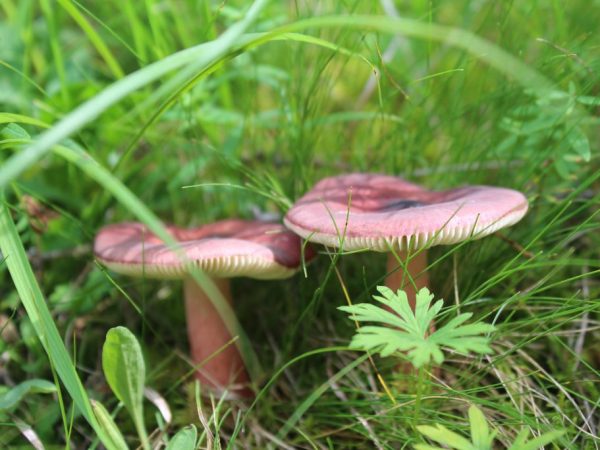
Popular russula mushroom
General description of the mushroom
Russula is a lamellar mushroom that belongs to the Russulaceae order, the Russula family, and the Russula genus. It grows in forests with deciduous trees or mixed coniferous-deciduous flora. It is often found at the bottom of ravines, forest edges, glades, next to other mushrooms. It is capable of developing only in a forest ecosystem, it does not lend itself to artificial cultivation. But some species are sometimes found even in the garden, if it is laid out next to the forest.
The distribution area covers almost the entire northern hemisphere. Mushrooms are found in Central, Western and Eastern Europe, the European part of Russia, the Caucasus, Siberia, the Crimea, and the countries of North America.
General description of russula mushroom:
- Hat: in young specimens, it is spherical or resembles a bell. Then, gradually opening up, it turns into a flat one. Over time, a notch appears in the center, the edges rise upward or become slightly bent. The cap is covered with a thin skin, which is relatively easy to remove; it adheres tightly to the pulp only in the center. Mushrooms are multi-colored, the color depends on the species.
- Hymenophore: the plates located from the bottom of the cap grow tightly with it. They are mostly white (less often ocher), with grooves and pointed edges, radiate radially from the center to the edges, long and brittle.
- Leg: usually in the shape of a cylinder, the lower part is even, slightly narrowed, much less often - thickened. Inside, it is at first filled, plump, but in old fungi it may be hollow. There are species in which the leg is always hollow.
- Pulp: breaks easily, brittle, solid or spongy. Painted white or other light colors. When damaged, it turns pink only in some inedible varieties.
- Spores: microscopically small, but in the total mass, the spore powder, visible to the naked eye, can be white or yellowish.
Different types differ in shade or shape of the cap, but their general characteristics are similar. They are all known to mushroom pickers and are often found.
Irina Selyutina (Biologist):
Russula are mycorrhizal fungi and they are often found both under various deciduous trees (oak, birch, alder) and under representatives of conifers (spruce, pine).
There are many useful substances in russula. So, 1 kg of russula contains 264 mg of vitamin B and 6 mg of vitamin PP.
For consumption, the best, according to "seasoned" mushroom pickers, are those species in which the color is dominated by green, blue or yellow and much less red.
The mushroom has many beneficial properties. It is able to lower blood lipids. Extracts from the mycelium have an anti-cancer effect. Extracts from fresh mushrooms are drunk as an antiparasitic and diuretic.
Edible russula species
There are several dozen edible russula. Not all of them grow in Russia, some are rare. For most, the tops are painted in gray-green, yellow or blue tones.
Food russula
This species is one of the most delicious varieties. She is born with a semicircular cap, which is then aligned, and an indentation is formed in the center. The color is brown with different shades: gray, lilac, beige, green - there are also white mushrooms. The peel is removed in half. Under the cap, frequent light plates are clearly visible, in which clavate or ovoid spores mature.
The leg is an even cylinder, without thickenings along its entire length. The lower part is yellow-brown or the same as the cap. The pulp is firm, crispy, with a slight nutty flavor.
The collection starts in the middle of summer and ends in September. Mushrooms are found in the forest with coniferous or deciduous trees. A related gray species often grows nearby.
Brown russula, or fragrant
Brown russula has a large cap with a diameter of up to 10 cm. From convex it gradually turns into a flat one. The skin can be burgundy or brown-olive. When it is dry outside, it is matte, in the rain it becomes velvety or glossy, it is easy to clean. The plates are spliced with the stem, white, but as the fungus grows, they acquire a yellowish-brown color.
The leg resembles a cylinder or a mace, it has a shade of red carmine. In young mushrooms, it is solid, in older ones, it is hollow. When broken, the flesh becomes brown, hence the name of the mushroom. After drying, the smell of shrimp is noticeably felt. The mycelium is in symbiosis with pine and spruce trees.
Marsh russula
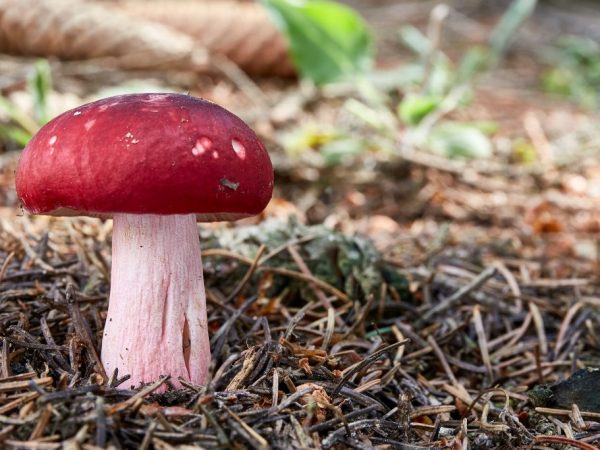
The russula Swamp is very tasty
Marsh russula is one of the most delicious varieties. Unlike other edible species, it has a red cap, which turns orange in older bodies. The top (cap) is fleshy and convex, the skin is dry. The plates are frequent, are branched, grow to the stem. They are brown or creamy yellow.
The leg is about 10 cm long, medium thickness (1-3 cm), resembles a spindle or a club. Inside it is hollow, outside it has a pinkish tint. Young russula mushrooms have dense flesh, which becomes loose over time. The time of intense fruiting occurs at the end of summer and the first weeks of autumn. The species grows in deciduous and mixed forests. The mycelium grows together with the root system of oak, spruce, pine or birch, forming mycorrhiza.
Fork russula
The russula is forked, or multi-lamellar, has a funnel-shaped cap, 5-12 cm in diameter. It is colored in different shades of brown, sometimes gray, yellow or greenish, with an olive speck in the middle. The plates grow densely and go down, have a creamy, green-yellow tint with small brown specks. The skin on top is dry, it is removed only along the edges, in the center of the cap it can be velvety.
The leg tapers downwards, strong. After the rains, yellow spots form on it. The pulp is dense, crunches, slightly yellows when broken. It grows next to deciduous trees, ripens closer to autumn, mushrooms gather in small groups.
Russula brown-violet
The russula brown-violet has a fleshy cap with wavy edges, funnel-shaped. The color is purple with a brown tint, sometimes burgundy. The skin is sticky, in dry weather it becomes dry, with a matte sheen. It is removed from less than half the radius of the cap from the edge. The plates branch and grow to the stem. At first they are milky white; as the spores mature, they slightly change color and become creamy.
The leg has a pronounced thickening in the center, the base is narrow, with a yellowish tinge. The pulp is loose, breaks easily. Mycelium enters into symbiosis with birches and spruces. Harvesting is advised at the beginning of autumn: then the mushroom grows in small groups.
Russula blue
The azure, or blue edible, russula has a cap color that resembles amethyst stone. Sometimes olive, lilac shades are visible. She has a dense and thick cap, the skin is easily removable, and is covered with a gossamer-like bloom on top. The plates are frequent, branching at the stem.
The leg of the russula is thickened, narrowed at the top, white, the structure changes from dense to spongy. In young fungi, it is covered with velvety pubescence. The pulp breaks easily, tastes sweet, without aroma. This species is found under fir trees in August and September.
Russula white-black
Russula of this type is often called "black and white podgruzdok". They are characterized by caps with a diameter of 7-12 cm and an off-white color, which, as the fungus matures, changes to brown or almost black. It is concave in the middle, the edges are slightly wavy or straight. The plates forming the hymenophore are narrow and frequent, of different lengths and turn black in age fungi. The leg is short, plump with a dense center. Russula of this variety resemble milk mushrooms, but milky juice does not appear at the site of the incision. The taste of the mushroom has a mint note. The variety grows among mixed trees and is harvested before early October.
Russula maiden
This type of russula is characterized by a thin-meat cap, flat or with a small dent in the center, and grooved edges. From above, the color of the mushroom is brick or brown-lilac, fades over time. The plates grow densely, at first they are white, over time they become beige, branch near the leg and are fused with it. The skin peels off well, it becomes darker in the rain.
The leg is in the shape of a spindle or cylinder, thick, on the cut it will take on a dirty yellow color. The middle of the leg is spongy or hollow. The pulp is fragile, turns yellow when damaged. This russula tastes sweet and has no aroma. Grows under spruce, pine, beech, oak, fir.
Russula blackening
The second name of the species is black podgruzdok. It belongs to the group of conditionally edible mushrooms. The pulp has a slight bitterness, but not poisonous. The cap turns from a convex into a flat one in age fungi, with a central recess. The color is brown, then almost black, more intense in the middle. In aging mushrooms, cracks appear on the surface. The peel is sticky at high humidity, it collects debris, needles, fallen leaves.
The hymenophore is pink-brown, sometimes black. The plates are thickened and sparse. The stem is elongated and cylindrical, first white, then brown. When cut, the flesh turns pink. The species grows in the forests of Western Siberia, Karelia, and is also found in Western Europe.
Russula greenish, or scaly
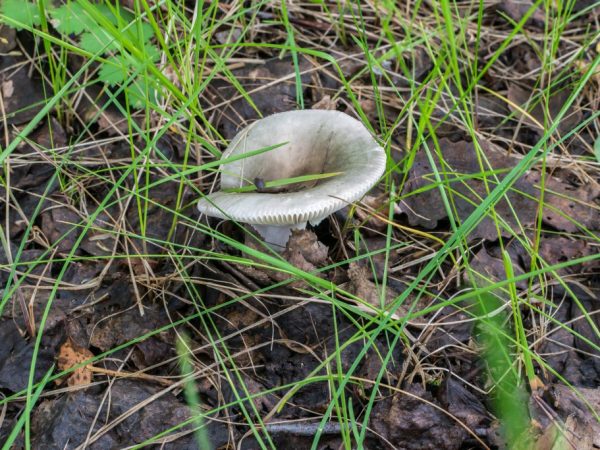
Russula are versatile in use
Greenish or scaly at the beginning of life has a semicircular cap, then a depression appears in the center, the edges are turned inside out. The color is green or gray-green. The skin cracks on the periphery, has small scales on top, it is easily cleaned up to almost half of the cap surface. The plates are rare, white in young specimens, fawn in old specimens.
The leg is fleshy and plump, in the shape of a cylinder. The pulp has an original nutty flavor. It is considered one of the most delicious, suitable for frying, stewing, pickling.
Irina Selyutina (Biologist):
Despite the fact that in its taste the greenish russula resembles a related species - the green russula, but outwardly this species is very similar to the pale toadstool, as a result, mushroom pickers very often bypass it. This is due, as you understand, to the enormous danger to human life and health, which is fraught with the pale toadstool.
For your information. In contrast to the greenish russula, the russula species has a green cap that has a grassy green, sometimes yellowish-brown color.
The autumn variety appears in September, grows in deciduous forest, prefers acidic soil.
Smelly russula, or pig
Smelly, value, pig or oatmeal, is considered a conditionally edible mushroom, has a bitter taste. The hat is semicircular at first, then straightened. Its color is with violet, purple, brown, olive shades. The skin on top is covered with mucus, rough. The plates of the hymenophore are off-white; if damaged, they secrete dark juice.
The stem is thickened, dense, with a reddish tint, which turns gray in old mushrooms. The pulp is fleshy, becoming brown in the cut. The species got its name because of its interesting smell. Someone compares it to a herring, to someone the aroma resembles almonds or oatmeal, and to someone and rancid oil. So that the pigs do not taste bitter, they are pre-soaked, then boiled in several waters. They are suitable for pickling and pickling.
Did you know? Salted valuei are an invariable attribute of folk stories, as an amazing delicacy in its taste. These mushrooms are mentioned even by VA Soloukhin in the book "The Third Hunt".
Russula golden
A rare golden variety found in deciduous forests. The hat gradually turns from a semicircular into a flat one with a slight indentation in the center. The color is red-yellow, orange and brick, reminiscent of gold. Blades are rare, with branches (sometimes repeated), ocher color.
The leg is dense, in old mushrooms, the inside is filled with cotton-like contents. The surface is rough, scaly. The shade is white, gradually turns brown. The middle is strong at first, but softens with age. There is no smell, the taste is soft, sweetish.
Almond russula, or cherry laurel
Almond or cherry laurel russula in youth has a convex cap, which becomes concave by the time the spores mature. The color first resembles yellow ocher, then turns brown. Plates are frequent, with sharp edges, of unequal length, in old age they acquire a rusty color.
The leg is cylindrical, below it is brown, fleshy. This russula tastes a little pungent, has a pronounced almond aroma, which is why it is called almond. The species grows in deciduous or mixed forests, the mycelium forms a symbiosis with oak and beech trees.
Inedible russula
There are practically no truly poisonous mushrooms in the russula genus. Some species accumulate small amounts of toxins that can cause stomach upset, mucosal irritation, or acute gastritis. But fatal poisoning by these mushrooms has not been recorded.
Inedible varieties have a bitter, sometimes pungent taste, and therefore are not suitable for harvesting and cooking. Most of the caps are bright red; on the cut, the flesh acquires a pink tint. But there are also exceptions.
Russula fragile
The russula is fragile and small in size, its cap is about 6 cm in diameter, has a flat shape with a slight indentation in the center. The color is lilac-purple with admixtures of red, brown green and gray colors. The skin is slimy, easy to clean. The plates are sparse, free, with serrated edges.
The leg is in the form of a club or cylinder, at first white, then turns yellow. With age, its density also changes: in young mushrooms, the leg is strong, in older ones - fragile. The pulp is brittle, its color is white or yellowish. The aroma is sweet, the taste is bitter.In terms of taste, this mushroom belongs to category 4 and it is conditionally edible, it is eaten only salted. But the bulk considers it inedible.
Russula pink
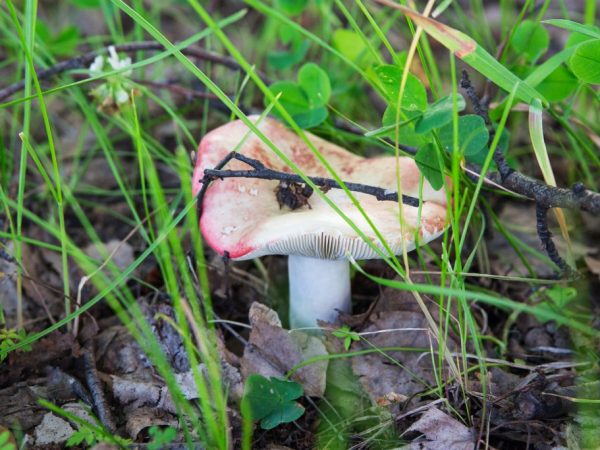
The mushroom has a bitter taste
The russula pink is considered conditionally edible. In appearance, it resembles a distant relative - an edible russule-like hygrophor. It has a bitter taste, but it disappears after soaking and long boiling. The hat is semicircular, without indentations. The color is from dark red to pale pink. The skin is dry, mucus appears only in wet weather. The plates fit tightly to each other, have a pink tint.
The leg is solid, in the shape of a cylinder. The pulp is firm, but crumbles easily. To get rid of the unpleasant taste, the russula is soaked in water for about 5 hours. Then you need to boil it for 1.5-2 hours, drain the water 1-2 times.
This species is found everywhere. Forests prefers broad-leaved, but it can be found in coniferous forests.
Blood red russula
The russula is red, or blood red, so named because of its bright cap color, which often fades and becomes whitish as a result. The peel is very difficult to separate from the surface of the cap. The plates are frequent, branching, passing to the leg, at first whitish, then acquire a creamy shade.
The leg is in the form of a cylinder, with a pink or reddish color, in the lower part it turns yellow. Hollow inside. The pulp is dense, pink under the skin itself. It tastes bitter and pungent and has a fruity aroma. If such russules are eaten raw, it is easy to get serious stomach upset.
Mayr's russula
Mayra's russula, or noticeable, grows in many European countries, is found in beech forests. The cap is not at first blood red, then turns pink due to washing out of the pigment. The shape is spherical, then it becomes convex, with a slight depression in the center. Plates are frequent, whitish in young mushrooms and creamy in old ones.
The stem is cylindrical with a slight pink tint, brown-yellow at the base. The pulp is dense, reddish when broken, has a honey-fruity smell. The russula of this species tastes pungent, bitter and pungent. It is considered to be poisonous, and in its raw form causes indigestion.
Russula Kele
The russula Kele has a dark purple-violet, lilac or violet cap, sometimes greenish at the edges. At first, it grows in a semicircle, then it becomes flat, and after the formation of spores, its edges are bent up. The plates are white, with age they become dirty gray or creamy, grow widely and grow to the stem. The peel is poorly removed, only along the edge of the cap.
The stem is in the form of a cylinder, painted in an intense pink-purple color. The base of the leg can be painted yellow. Smooth above, with slight edging, dense inside. The pulp is dry and brittle, purple under the skin, almost does not change color when broken, but may turn yellow a little. The aroma is very weak, almost imperceptible, with light fruity notes. The taste is bitter and pungent. The mushroom is not poisonous, but once it gets into the dishes, it spoils all the mushrooms.
Pungent russula
The russula is stinging, or vomiting, or nauseous, found in all types of forests. She has a red hat, semicircular in her youth, then becomes flat. The plates are white; in old age, the fruiting body turns yellow. The skin separates well from the surface of the cap. The leg has a faint pink tint, a cylindrical shape. In mature fungi, it turns yellow, which is especially noticeable at the base. The taste is bitter and pungent.
The species is considered weakly poisonous. The mushroom contains small doses of muscarine. There have been no deaths after consuming this species, but it can cause serious stomach problems. Some mushroom pickers use it for pickling. In this case, the mushrooms are boiled for 20 minutes, and then washed well in running water.
Russula sardonyx
The russula spicy, or sardonyx, or yellowing looks attractive, has a purple-red or red-brown cap, sometimes with a green or yellow-green tint. The shape is flat with a small depression in the center, convex in young specimens. The plates are frequent, adhere to the leg and descend a little on it. The shade of the plates is bright yellow or lemon.
The stem is fusiform, sometimes cylindrical, with a spongy structure. The color of the leg is lilac or purple-pink. Very rarely, a white tint is found in the color of the leg. The pulp is firm, with a yellowish tinge, has a weak fruity aroma, pungent taste, and in its raw form causes mild poisoning.
Russula value-shaped
The value russula variety has an ocher-colored cap, sometimes yellow-brown, cream or gray-brown. At first, the shape of the cap is semicircular, then it becomes flat, a bulge appears in the center. Old mushrooms can also have funnel-shaped caps. The edge is wavy, serrated. The plates are white, darken with age.
The leg is dense, solid, then becomes hollow (air chambers are formed in it), the color changes from white to creamy yellow. The smell is pronounced mushroom, fruity or honey. The taste is pungent (pungent in the cap, bitter in the plates). There is no consensus on the edibility of the species.
Found in mixed and deciduous plantings, ripens in late August and September.
Russula bilious
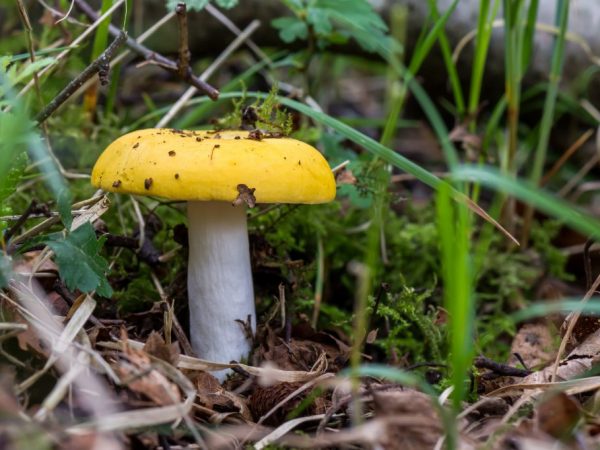
Bile russula is inedible
The variety, called bilious russula, has a flat cap with a small tubercle in the center, painted in a yellow-straw color. The edges are slightly ribbed, the skin is sticky on top, it is peeled only along the edge. The blades can branch, they are often located at the stem and rarely at the edge of the cap, have a light ocher color with yellowish edges.
The leg is in the form of a spindle or club, hollow, a shade of light ocher, wrinkles in old age. The pulp is white, has a geranium smell. The taste is pungent, because representatives of this species are classified as inedible.
How to collect russula correctly
Russula is an edible fragile mushroom, it breaks easily, especially during transportation. You need to collect it in a basket, without putting too many mushrooms on top of each other. You need to look for fruiting bodies under the trees. Because young specimens hide in the litter, it is carefully raked so as not to damage the delicate caps. The leg is cut off with a sharp knife. Be sure to look at the base so as not to be confused with poisonous mushrooms. Before putting the find in the basket, it is checked for the presence of worms. If there are many of them, it is better to discard the mushroom: it will infect the rest.
How to distinguish from a pale toadstool
The most poisonous mushroom in our forests is the pale grebe. She looks like a russula.
Description and distinctive features of toadstool:
- The cap of a young mushroom has an ovoid shape, in the old one it is flat, without a depression in the center.
- The color is greenish, pale yellow, yellow, yellow-green.
- Leg 8-16 cm, colored like a cap, only lighter, hollow in older specimens.
- In the lower part there is a characteristic ovoid "pouch".
- A dense ring is visible under the cap on the leg - the remains of a private veil that covered the hymenophore and thus connected the cap and the leg.
- The pulp is odorless, and it is never seen on the cut that it turns blue or yellow.
Here are a few things to look out for when differentiating between these 2 types:
- An edible mushroom never has a ring on its stem.
- The leg is always thicker than that of the pale toadstool and in relation to the cap, in most edible species it is white or slightly yellowish, sometimes pink when the cap is red.
- There is never any thickening at the bottom.
- Worms do not eat pale toadstool - it is always whole.
Not only the toadstool's fruiting bodies are poisonous, but also the spores. If russula and toadstool grow under the tree, you cannot pick an edible mushroom. Poisonous spores fall on him, and he becomes dangerous.Also avoid picking berries that grow next to the pale toadstool. Experts believe that within a radius of 3 m from the pale toadstool, not only should you not pick mushrooms or berries, but even touch anything with your hands.
Conclusion
Russula mushrooms are famous, tasty and healthy. They are widespread in forests. Cooking this type is simple: boil for 10-15 minutes, then stew, fry, pickle or salt. Sometimes russula are dried, but they do not have their own characteristic smell, therefore they are inferior in quality to other mushrooms. The main thing when collecting is to remember the main features of the species and not to confuse it with its poisonous counterparts.


